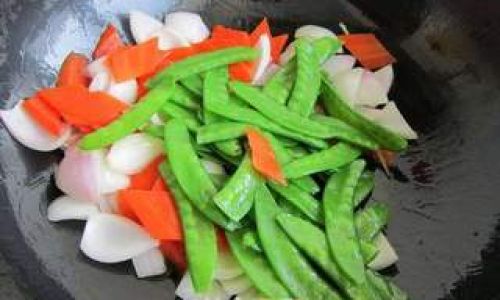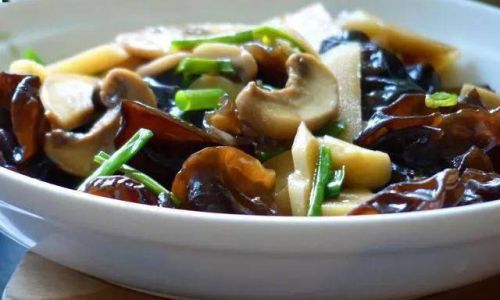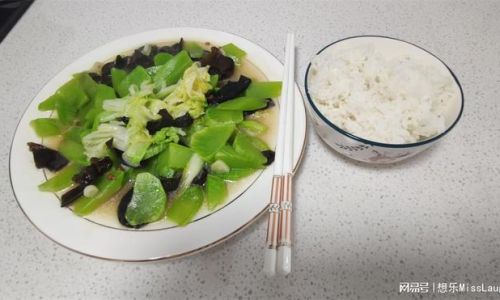Mastering the Art of Stir-Fried Vegetarian Three Delights: A Flavorful Journey Through Fresh Ingredients and Simple Techniques*
Stir-fried vegetarian three delights, known in Chinese cuisine as chǎo sù sān xiān*, is a vibrant, nutrient-packed dish that celebrates the harmony of textures and flavors. This classic recipe combines crisp vegetables, earthy mushrooms, and delicate seasonings to create a meal that is both satisfying and light. Whether you are a seasoned home cook or a novice in the kitchen, this guide will walk you through every step to achieve a restaurant-quality dish bursting with color and taste.
At its core, vegetarian three delights is a celebration of simplicity and balance. The dish traditionally features three key ingredients: fresh mushrooms, crunchy bell peppers, and tender bamboo shoots. However, modern adaptations often incorporate other vegetables like carrots, snap peas, or water chestnuts to add variety. The name “three delights” refers to the trio of flavors—sweet, savory, and umami—that emerge from the combination of ingredients and careful cooking techniques.
This dish is not only a feast for the palate but also a visual delight. The vibrant hues of red bell peppers, green vegetables, and dark mushrooms create a plate that is as appealing to the eye as it is to the taste buds. Beyond its aesthetic appeal, vegetarian three delights is prized for its health benefits. Packed with fiber, vitamins, and antioxidants, it is a low-calorie, high-nutrient option that aligns with plant-based diets and mindful eating.

Ingredients: Selecting the Freshest Produce
The success of this dish hinges on the quality of its ingredients. Here’s a breakdown of the key components and tips for selecting the best produce:
-
Mushrooms: Use a mix of shiitake, oyster, or enoki mushrooms for depth of flavor. Fresh mushrooms should be firm, dry, and free of blemishes. Dried shiitake mushrooms can be rehydrated for a richer taste, but ensure they are thoroughly rinsed to remove grit.
-
Bell Peppers: Opt for a combination of red, yellow, and green bell peppers for color contrast. Look for peppers with glossy skin and a firm texture. Avoid those with wrinkles or soft spots.
-
Bamboo Shoots: Canned or fresh bamboo shoots work well. If using canned, drain and rinse them to eliminate any metallic taste. Fresh bamboo shoots require peeling and boiling before use.
-
Carrots: Choose young, tender carrots with vibrant orange flesh. They add a subtle sweetness and crunch to the dish.
-
Snap Peas: Select plump, bright green pods that snap crisply when broken. Avoid limp or yellowing peas.
-
Aromatics: Fresh garlic, ginger, and scallions are essential for building flavor. Minced garlic and ginger should be fragrant, while scallions should be crisp and green.

-
Sauces: Light soy sauce, oyster sauce (vegetarian version), and a touch of sesame oil form the flavor base. For a gluten-free option, use tamari instead of soy sauce.
-
Seasonings: A pinch of sugar balances the savory notes, while white pepper adds a subtle heat. Cornstarch helps thicken the sauce for a glossy finish.
Equipment: Tools for Stir-Frying Success
Stir-frying is a high-heat cooking method that requires the right tools to achieve optimal results:
- Wok or Large Skillet: A well-seasoned carbon-steel wok distributes heat evenly and allows for quick tossing. A large nonstick skillet is a suitable alternative.
- Sharp Chef’s Knife: Essential for precision slicing and dicing.
- Cutting Board: Use a wooden or plastic board to prevent dulling your knife.
- Spider Strainer or Tongs: For tossing ingredients without damaging the wok’s surface.
- Small Mixing Bowl: To pre-mix the sauce ingredients.
- Ladle or Spatula: For stirring and scraping the wok.
Step-by-Step Preparation: From Chopping to Serving
Mise en Place: Prepping the Ingredients
The key to efficient stir-frying is preparing all ingredients before lighting the stove. This technique, known as mise en place, ensures that cooking proceeds smoothly without overcooking any component.
- Slice the Mushrooms: Thinly slice shiitake or oyster mushrooms. If using enoki, trim the roots and separate the strands.
- Julienne the Vegetables: Cut bell peppers, carrots, and bamboo shoots into thin, even strips. This ensures they cook quickly and evenly.
- Trim the Snap Peas: Remove the strings from snap peas by pinching the stem end and pulling downward.
- Mince the Aromatics: Finely chop garlic and ginger. Slice scallions into 1-inch segments, separating the white and green parts.
- Prepare the Sauce: In a small bowl, combine 2 tablespoons of light soy sauce, 1 tablespoon of oyster sauce, 1 teaspoon of sugar, ½ teaspoon of white pepper, and 1 tablespoon of cornstarch. Add ¼ cup of water and stir until the cornstarch dissolves.
Mastering the Stir-Fry Technique
Stir-frying is a dance of heat, timing, and motion. Follow these steps to achieve perfect results:
- Heat the Wok: Place the wok over high heat and add 1 tablespoon of vegetable oil. Swirl the oil to coat the surface.
- Stir-Fry the Aromatics: Add the minced garlic and ginger. Stir-fry for 10–15 seconds until fragrant but not browned.
- Cook the Mushrooms: Add the sliced mushrooms to the wok. Stir-fry for 2–3 minutes until they release their moisture and begin to brown.
- Add the Vegetables: Toss in the bell peppers, carrots, and bamboo shoots. Stir-fry for 2 minutes, keeping the vegetables moving to prevent burning.
- Incorporate the Snap Peas: Add the snap peas and continue stir-frying for another minute. The vegetables should remain crisp and vibrant.
- Pour in the Sauce: Give the pre-mixed sauce a quick stir (cornstarch may settle) and pour it into the wok. Toss gently to coat all ingredients.
- Finish with Scallions: Add the white parts of the scallions and a drizzle of sesame oil. Stir-fry for 30 seconds until the sauce thickens.
- Garnish and Serve: Transfer the dish to a serving platter. Sprinkle with the green scallion segments and a pinch of toasted sesame seeds for added texture.
Tips for Perfect Stir-Fried Vegetarian Three Delights
-
High Heat is Key: Stir-frying requires temperatures between 375–450°F (190–232°C) to seal in flavors and textures. Avoid overcrowding the wok, as this lowers the heat and steams the vegetables instead of stir-frying them.
-
Cut Ingredients Uniformly: Even slicing ensures that all components cook at the same rate. Thicker pieces will remain raw, while thinner ones may turn mushy.

-
Pre-Mix the Sauce: Combining sauces and seasonings beforehand prevents scrambling to measure ingredients mid-cooking. This step also ensures the cornstarch dissolves completely, avoiding lumps.
-
Don’t Overcook: Vegetables should retain their crunch. Overcooking results in a soggy texture and dull colors.
-
Adjust Seasonings to Taste: Feel free to tweak the sauce with a splash of rice vinegar for acidity or a pinch of chili flakes for heat.
Nutritional Benefits: A Powerhouse of Health
Vegetarian three delights is a nutritional powerhouse. Here’s a breakdown of its health benefits:
- Mushrooms: Rich in B vitamins, selenium, and antioxidants, mushrooms support immune function and reduce inflammation.
- Bell Peppers: High in vitamin C (more than oranges!), they boost collagen production and skin health.
- Carrots: Loaded with beta-carotene, they promote eye health and immune defense.
- Bamboo Shoots: Low in calories and high in fiber, they aid digestion and regulate blood sugar.
- Snap Peas: Excellent sources of vitamin K and iron, they support bone health and oxygen transport.
This dish is also naturally low in saturated fat and cholesterol, making it ideal for heart-conscious diets.
Variations and Customizations
One of the joys of vegetarian three delights is its versatility. Experiment with these twists:
- Protein Boost: Add cubed tofu, tempeh, or edamame for plant-based protein.
- Spicy Kick: Incorporate sliced chili peppers or a dash of Sriracha.
- Nutty Crunch: Top with toasted cashews, peanuts, or sesame seeds.
- Fermented Flavors: A splash of black vinegar or kimchi juice adds tanginess.
- Herb Infusion: Garnish with fresh cilantro, basil, or mint for a bright finish.
Pairing Suggestions: Completing the Meal
Vegetarian three delights pairs beautifully with:

- Steamed Jasmine Rice: The fluffy grains absorb the sauce beautifully.
- Brown Rice or Quinoa: For a nutrient-dense twist.
- Noodle Stir-Fries: Toss with udon or soba noodles for a heartier meal.
- Light Soups: Serve alongside miso soup or tofu-vegetable broth.
- Appetizers: Start with spring rolls or dumplings for a multi-course feast.
Cultural Context: The Philosophy of Balance
In Chinese cuisine, dishes like vegetarian three delights reflect the principle of yin and yang—the balance of opposing forces. The crispness of vegetables represents yang (energy and warmth), while the earthiness of mushrooms embodies yin (calm and coolness). Together, they create harmony on the plate.
This dish also aligns with the concept of qi (vital energy), emphasizing fresh, seasonal ingredients to nourish the body and spirit. By using minimal oil and maximizing flavor through aromatics and sauces, it embodies the ethos of huǒ hòu (fire control)—the art of mastering heat to transform simple foods into culinary delights.
Conclusion: A Dish for Every Occasion
Stir-fried vegetarian three delights is more than a recipe—it’s a testament to the beauty of simplicity. Whether you’re seeking a quick weeknight dinner, a showstopping side dish, or a way to introduce children to vegetables, this dish delivers. With its vibrant colors, crisp textures, and balanced flavors, it captures the essence of Chinese home cooking while adapting effortlessly to modern palates.
So, gather your ingredients, heat your wok, and embark on a culinary journey that celebrates the joy of fresh, wholesome food. As you savor each bite, remember that the greatest delights often lie in the simplest of preparations. Happy cooking!





0 comments